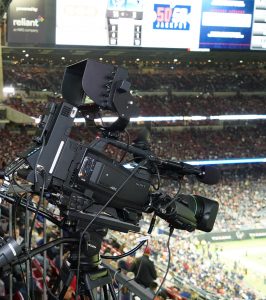Inside Look at the NBC Sports, Sony, Verizon 5G Trial at NRG Stadium
Results indicate the potential for high-quality, low-latency wireless in sports production
Story Highlights
A recent 5G technical production trial by Sony, Verizon, and NBC Sports gave Sony an opportunity to flex its full corporate muscle: a Sony Xperia 5G mm wave device provided the data uplink for a Sony PXW-Z450 camcorder and a 5G HEVC codec, enabling broadcast-quality signals to be sent over Verizon’s 5G network at NRG Stadium in Houston. A USB-C cable connected the camcorder to the Xperia device.
According to Ali Amoli, director, Imaging Productions & Solutions, Americas, Sony Intelligent Media Services, although the system is still in the design phase, the demonstration revealed that high-bandwidth, low-latency sports production via 5G is possible.

Sony, Verizon, and NBC Sports worked together on a system at NRG Stadium to deliver 1080p HDR signals via public 5G services.
“Together, the Sony Professional Group and Sony Mobile are in a unique position to put these solutions together,” he says. “With 5G, there is more flexibility, and it is easier to set up, especially when the infrastructure is more widely deployed. And, down the road, there are a lot of possibilities with mobile edge computing and connectivity to cloud services.”
The pilot project had been in discussions for about a year. According to Todd Donovan, VP, engineering technology, NBC Olympics, the NFL game in Houston was the perfect spot, given that it is one of two stadiums where Verizon has a 5G deployment that is ready to go. NBC Olympics also has a long-term partnership with Sony, so, when Donovan and his team heard that Sony was working on a 5G codec and transmission solution that could be bolted onto an existing camera, they were intrigued.
“You’re always looking for any sort of production or technical tool that can help with the storytelling,” Donovan explains. “When it comes to high-quality, low-latency wireless, we use proprietary RF solutions with specialized equipment, vendors, and frequency coordination. So the opportunity to have a more easily deployed, commodity-based system for satisfying changing requirements is interesting.”
He adds that the cameras, which were not available to the Sunday Night Football crew and did not interfere with its needs, were located on the third deck at the 50-yard line and also on the sidelines. Verizon has a half dozen 5G antennas in the stadium intended to make sure the fans have connectivity, not necessarily to aid camera operators who may be on the sideline. Donovan says it was important to make sure the cameras stayed within the signal range, and the result was transmission of 1080p HDR signals at upwards of 40 Mbps over public 5G services.
“The picture quality [was] really good,” he says. “You wouldn’t think it was a public connection. Both signals arrived in time with each other, and we learned that the dynamics of 5G make antenna placement and coverage important.”
Verizon and Sony are carefully looking into the trial results to evaluate network latency and discuss improvements, says Haji Kamata, GM, Sony Imaging Products & Solutions – Americas. “We will continue our efforts to drive 5G-technology adoption as an innovative and flexible tool for live sports production.”
Donovan’s team is going to take a closer look at picture quality and other specifications.
“We want to learn more about end-to-end latency and resiliency,” he explains. “I don’t think this is meant for stadiums and arenas to replace the wired camera positions but rather to easily add a couple of wireless cameras with less planning. Or at smaller, collegiate sports events or news events in parks, it would be great to skip wiring and also have no frequency coordination.”
Amoli points out that the approach’s real-world deployment depends on the speed of 5G-network deployment. Sony has done tests in Europe and Asia as well, and the combination of the Sony divisions working together portends great things.
Says Kamata, “There is definitely a long-term commitment between Sony, NBC, and Verizon, and specific plans for next year are still in discussion.”
